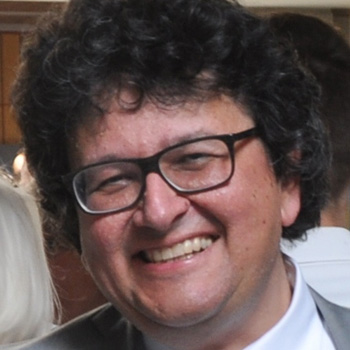Plant breeding using CRISPR-Cas molecular scissors
Holger PuchtaOccupation:
Plant molecular biologist
Position:
University professor and head of the Botanical Institute at the Karlsruhe Institute of Technology

Occupation:
Plant molecular biologist
Position:
University professor and head of the Botanical Institute at the Karlsruhe Institute of Technology

Holger Puchta is one of the first researchers worldwide to utilise the CRISPR-Cas molecular ‘scissors’ in the area of plants. For the biotechnologist at the Karlsruhe Institute of Technology, the editing tool heralds a new era of precision in plant breeding.
Researchers first presented the CRISPR-Cas genomic scissors in 2012 in the journal Science. In the meantime, the molecular precision tool has revolutionised the field of molecular biology. Holger Puchta from the KIT is one of the first researchers to use these genomic scissors to make targeted modifications to the genetic material of plants. In the interview, he explains how so-called genome editing works, and why the agricultural crops that result from this technology are indistinguishable from natural plants.
The CRISPR-Cas nuclease is barely five years old and yet counts among the most popular tools in plant molecular biology. What procedures are possible using these molecular scissors?
At this time, the vast majority of researchers are using the technology to eliminate individual genes that are responsible for particular undesirable properties. This is achieved with a single specific incision, whereby CRISPR-Cas creates a double-strand break in the DNA of the respective gene. The break is then naturally repaired by the plant – as with any other genetic damage. However, this frequently inaccurate repair process often results in the loss of the gene function. In addition, CRISPR-Cas allows for the possibility of a targeted incorporation of foreign DNA into specific locations within the genome. Another special feature is that in the test runs, these targeted interventions can be undertaken simultaneously.
How does the use of designer nucleases in plant cultivation differ from classical methods of mutagenesis?
Few people are aware that the technique of using double-strand breaks to create new properties in plants is not five but 70 years old. Its application in agriculture has been so successful that today more than 3000 such varieties are cultivated worldwide. Originally, these breaks were induced by radioactive radiation and subsequently repaired by the plant. The significant disadvantage of this technology, which is known as classical mutagenesis, is that breaks are induced not only specifically at the ‘right’ location, but also at numerous other points within the genome. To call this ‘carnage in the genome’ would be no great exaggeration. The majority of mutations result in growth deficiencies, and it’s only with a great deal of luck that you end up with a plant that exhibits properties that are interesting for agriculture, such as short-stemmed barley. It’s a laborious process. Moreover, it’s virtually impossible to create plants without additional mutations. CRISPR-Cas or other designer nucleases, on the other hand, can be specifically programmed to take effect at a desired point in the genome, and this precision carries through into the breeding.
Would you describe plants that have been altered with molecular scissors as ‘genetically modified organisms’ (GMOs)?
You have to differentiate. If foreign sequences have been incorporated in the genome – as with classic transgenic plants – the plant is clearly a GMO. The majority of CRISPR-Cas applications, however, result in plants with only individual additional mutations. Since these mutations are caused by natural repair, and because these kinds of mutations occur naturally all the time, it is simply not possible from a scientific perspective to distinguish such a plant from a natural plant. They are ‘nature-identical’. If these kinds of plants are defined as GMOs, there will be no actual means of verification. Even those varieties produced using mutagenesis – which carry far greater numbers of mutations – do not fall under GMO regulations. In my opinion, it would thus be exceedingly irrational to classify such plants as GMOs.
How do you view the current debate on the regulation of genome-edited plants – both here in Germany and internationally?
It’s good and important that there is a debate on the subject that includes the general public. Even to the layperson, it is clear that the development of genome-edited plants represents an improvement to the generally accepted technique of classical mutagenesis. Likewise, the public is not aware just how frequently natural mutations occur, and that no two plants are genetically identical. Ultimately, it is also important that we talk about the risks: We have been researching double-strand breakage repair in plants for 25 years, and as a result we have precise knowledge of what can be achieved using the technology, but also the effects that can be triggered. Of course, a rational discussion in Germany and Europe is particularly difficult to pursue because the public is traditionally highly critical of green genetic engineering. In other countries such as Canada, the USA or Argentina, genome-edited plants have already been classified as non-GMOs.
Critics complain that the technology is not as precise or safe as described. What does the possible occurrence off-target effects – i.e. erroneous incisions – mean for researchers and plant breeders?
As with numerous technical innovations, there has been an impressive series of optimisations over the years. Indeed, many off-target effects could be observed with the first designer nucleases. In the meantime, the development of improved CRISPR-Cas systems means that undesired incisions are the exception and not the rule. Through the use of modern sequencing techniques, it is also relatively easy to check whether such effects have occurred. In this way, it is possible to select only those plants with none of these effects. Classic mutagenesis technologies create vast numbers of unwanted mutations. In contrast to medical applications, however, this problem is of secondary importance to breeders, who can simply attenuate unwanted mutations over several plant generations through the use of cross breeding.
Can you give us a few examples of how CRISPR-Cas has already been utilised successfully in applied plant breeding?
Because the technology has only recently been successfully applied to arable crops, we are still at the beginning of a development whose course is not yet possible to foresee. For the area of agriculture, the switching off of individual genes could bring a whole range of new and attractive properties. For example, it has already been possible to produce mildew-resistant wheat, as well as a form of soy with an altered composition of unsaturated fatty acids. A maize with a different starch composition has also been produced. There are other examples, and these are set to be joined by many more in the near future.
Interview: Philipp Graf


